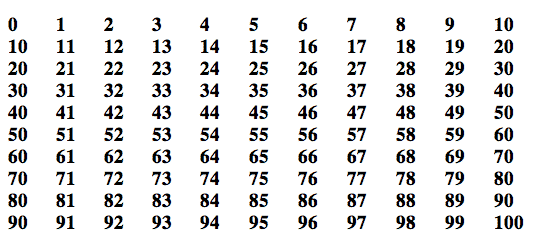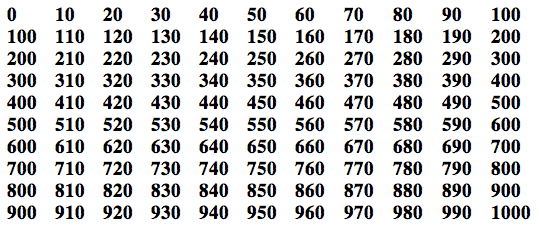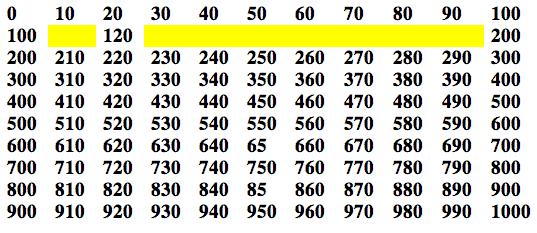|
Rounding to Nearest 10 or 100: Abstract Level
More Teaching Plans on this topic: Concrete, Representational
|
|
Phase
1
Initial
Acquisition of Skill
|
Phase
2
Practice
Strategies
|
|
|
|
PHASE 1: Initial Acquisition of Skill
Teach Skill with Authentic Context
Description: Continue to link abstract level instruction to contexts used to teach the skills at the concrete and representational/drawing levels.
Build Meaningful Student Connections
Purpose: to assist students to build meaningful connections between what they know about rounding to the nearest ten and/or hundred by drawing to rounding numbers without drawing pictures.
Learning Objective 1: Round to the nearest ten or hundred by identifying the talking digit in two and three digit numbers.
Materials:
Teacher -
- One example of the rounding process using concrete materials and a number line that can be clearly seen by all students.
- One example of the rounding process using drawings and a number line that can be clearly seen by all students.
- A written learning objective that is clearly visible to all students: “Use the TALKING DIGIT to round numbers to the nearest ten or hundred.”
Description:
1) L ink to students’ prior knowledge of rounding to the nearest ten and hundred using concrete materials, by drawing, and using a number line with drawings.
For Example:
You have learned to round to the nearest ten and to the nearest hundred by using three very helpful strategies. You first learned how to round by using concrete materials like these base-ten materials (Hold up/display an example of rounding with concrete materials.). You also have learned how to draw pictures to help you round to the nearest ten and hundred (Display an example of rounding a number with drawings and a number line.) Last, you learned how to use both concrete materials and drawings to round using a number line. (Point to the number line in both the concrete and drawing examples.)
2) I dentify the skill students will learn: “Round to the nearest ten or hundred by identifying the talking digit in two and three digit numbers.”
For Example:
Today, we are going to learn how to round to the nearest ten and hundred by using a number line without concrete materials or drawings. We are going to learn something special about the digits in the number we want to round. I will show you how to use the “Talking Digit” to help us round numbers to the nearest ten or hundred. (Display the written learning objective and point to it as you say it.) What are we going to learn today? (Point to the written learning objective and elicit the response, “Use the TALKING DIGIT to round numbers to the nearest ten and hundred.”) That’s right, we’re going to learn how to use the talking digit to round numbers to the nearest ten and hundred.
3) P rovide rationale/meaning for rounding to the nearest ten and hundred.
For Example:
Learning how to use the talking digit in a number to round will really help you to round when you don’t have concrete materials and when you don’t have time to draw in order to round a number. You will not always have concrete materials when you need to round and there will be times when drawing will take too long. What are some examples of times we might need to round a number to its nearest ten or hundred? (Prompt students to offer previous contexts used to teach at the concrete and representational levels and to offer “new” examples.)
[ back to top ]
Explicit Teacher Modeling
Purpose: to provide students a clear teacher model of rounding to the nearest ten and hundred without using concrete materials and without drawing.
Learning Objective 1: Round to the nearest ten or hundred by identifying the talking digit in two and three digit numbers.
Materials:
Teacher -
- An appropriate format to display numbers and number lines so that all students can see and hear.
- A selection of three digit numbers that are color coded (e.g. ones place is green, tens place is red, and hundreds place is blue – 347.)
- A language card with the following phrase written: “round to the nearest HUNDRED.”
- Number lines prepared that represent the appropriate “hundreds” the given three digit number might be rounded to. The numbers represented should be increments of ten and the tens digit should be color-coded appropriately.
For Example:

Description:
A. Break down the skill of rounding to the nearest ten or hundred by identifying the talking digit in two and three digit numbers.
1) Read the number.
2) Identify whether you are rounding to the “ten” or to the “hundred.”
3) Identify the “talking digit” and underline it.
4) Use number line and 'talking digit' to round to nearest ten or hundred.
5) Review what the "talking digit" is and how it helps when you need to round..
Learning Objective 2: Round by writing numbers to represent “counting on” and “counting back” to the nearest ten or hundred.
Materials:
Teacher -
- Chalkboard, dry-erase board, chart paper, or overhead to write on.
- Multicolored chalk, markers or pens for writing.
Description:
A. Break down the skill of rounding by writing numbers to represent “counting on” and “counting back” to the nearest ten or hundred.
1) Identify whether you are rounding to the nearest ten or hundred and decide what the “greater” and “lesser” ten or hundred is.
2) Identify the talking digit of the number to be rounded and decide whether the “talking digit” tells you to “count on” and “count back” by ones or by tens.
3) Count on by writing numbers (by ones for rounding to the nearest ten and by tens for rounding to the nearest hundred.).
4) Count back by writing numbers (by ones for rounding to the nearest ten and by tens for rounding to the nearest hundred.).
5) Compare the “count on” set of numbers to the “count back” set of numbers and decide which ten or hundred the number should be rounded to.
6) Write the nearest ten or hundred.
Learning Objective 3: Rounding to the nearest ten or hundred using proximity cues (Round to the Nearest Ten Chart or Round to the Nearest Hundred Chart).
*The Round to Nearest Ten Chart and Round to Nearest Hundred Chart provide students a clear teacher model of how to use proximity as a cue for rounding.
Materials:
Teacher -
- A “Round to Nearest Ten Chart” (i.e. a chart that depicts the numbers 0 –100 grouped by tens in rows so that each row depicts the “lesser” and “greater” ten:
For Example:

- A “Round to Nearest Thousand Chart” (i.e. a chart that depicts multiples of ten from 0-1000 grouped by ten multiples in rows so that each row depicts a the “lesser” and “greater” hundred.
For Example:

- Nine “peep hole” cards. Each card is one row wide and nine columns long. Each card has one square cut-out space positioned for one number position in columns 2-9 (e.g. one card when positioned between the first and last number in a row will reveal the second number in the row; the second card when positioned between the first and last number in a row will reveal the third number in the row; etc.
For Example:

*This “peep hole” card reveals the “third” number in a row when placed between the first and last number in the row.
Description:
A. Break down the skill of rounding to the nearest ten or hundred using proximity cues (Round to Nearest Ten Chart and Round to Nearest Hundred Chart).
1) Introduce the Round to Nearest Ten Chart and/or Round to Nearest Hundred Chart.
2) Identify a number to be rounded and whether it will be rounded to the nearest ten or hundred.
3) Identify which chart can be used for rounding to the nearest ten (Round to Nearest Ten Chart) and which chart can be used for rounding to the nearest hundred (Round to Nearest Hundred Chart).
4) Identify the “talking digit” and what number on the Round to Nearest Ten Chart or Round to Nearest Hundred Chart the “peep hole” card should be placed.
5) Choose the appropriate “peep hole” card to use and place it between the “lesser” and “greater” tens or the “lesser” or “greater” hundreds.
6) Model determining which ten or hundred to round to by pointing out the distance between the number you are rounding and each ten or hundred.
7) Repeat this process at least three times for both rounding to the nearest ten and to the nearest hundred.
[ back to top ]
Scaffold Instruction
Purpose: to provide students the opportunity to build their initial understanding of how to round numbers to the nearest ten/hundred without concrete materials or drawings, and to provide you the opportunity to evaluate your students’ level of understanding after you have initially modeled this skill.
Materials:
- Dependent on the skill you are Scaffolding Instruction for (See the materials listed for the specific skill you want to scaffold under Explicit Teacher Modeling).
Description:
*Scaffolding at the abstract level of instruction should occur using the same process as scaffolding instruction at the concrete and representational/drawing levels of instruction (See the description of Scaffolding Instruction for, “rounding to the nearest hundred using base ten materials and a number line,” in the Concrete Level Instructional Plan.). The steps listed for each skill during Explicit Teacher Modeling should be used as structure for scaffolding your instruction.
A. Scaffold instruction using a high level of teacher direction/support. (*Dependent on the needs of your students, you may want to continue to associate drawings to the abstract level rounding process during this phase of scaffolding. Move to the next phase of scaffolding only when students demonstrate understanding and ability to respond accurately to your prompts.
B. Scaffold instruction using a medium level of teacher direction/support. (If you associated drawings with the abstract process for rounding while scaffolding using a high level of teacher direction/support, then do not include drawings during this phase of scaffolding). Move to the next phase of scaffolding only when students demonstrate understanding and ability to respond accurately to your prompts.
C. Scaffold instruction using a low level of teacher direction/support. (Students should actually round as you prompt them during this phase of Scaffolding Instruction.) Move students to independent practice of the skill only after they demonstrate the ability to perform the skill with limited prompting from you.
[ back to top ]
Videos
Learning Objective 1: view Clip 1, Clip 2, Clip 3
Round to the nearest ten or hundred by identifying the talking digit in two and three digit numbers.
[ back to top ]
|



